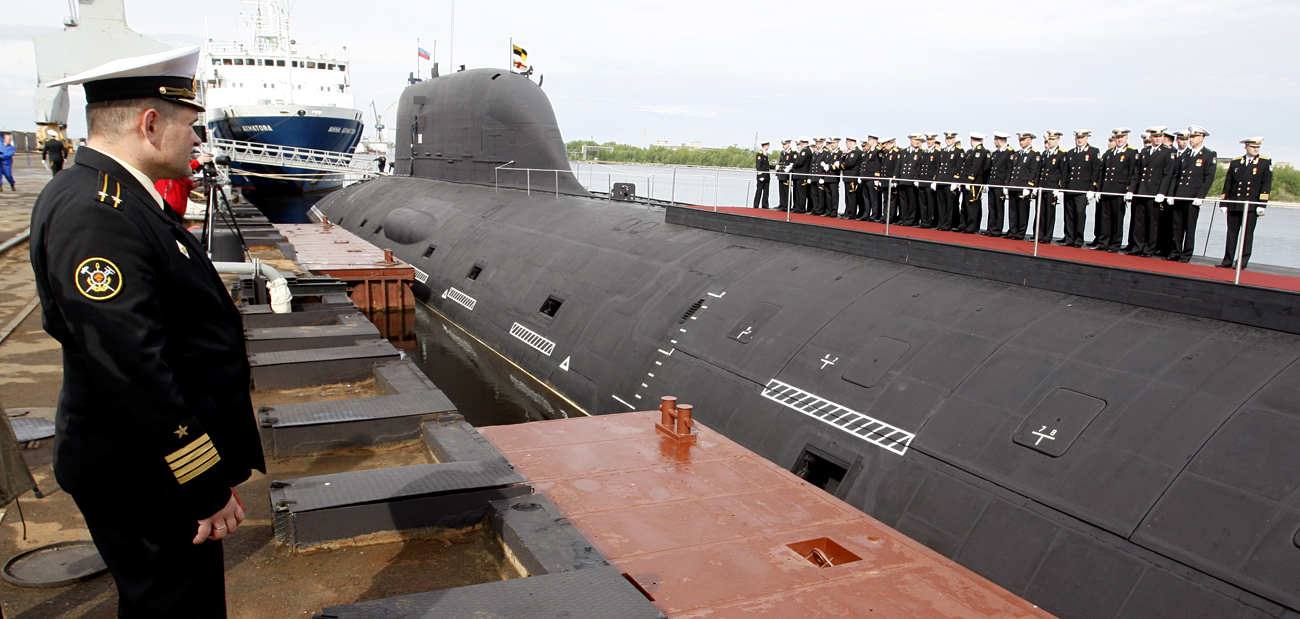New ‘Predator’ to boost Russian naval power

Yasen class nuclear attack submarine Severodvinsk being commissioned into the Russian Navy, at the Sevmash shipyard, June 2014. Source: Vladimir Larionov/TASS
Russian military analysts reported in early October that a group of designers were working for the navy to complete work on a completely new high-speed torpedo. The widely-known Shkval (“Squall”) torpedo, which has long been a global leader, in terms of speed and the destructive force of its warhead, will be replaced by a new torpedo, called Khishchnik (“Predator”).
No specific information is available yet on what the new torpedo is like and what its technical characteristics are: The project is classified. It is only known that it is being developed by the Elektropribor design bureau, which specializes in aviation technology.
The connection is not accidental: what is being developed is not just a torpedo but what is in effect an underwater missile whose engine has a lot in common with its airborne equivalents. In terms of its main specifications, the ‘Khishchnik’ will overtake the ‘Shkval’, its famous predecessor.
Underwater record breaker
A project brief to develop a fundamentally new torpedo, capable of carrying a nuclear warhead, was issued in the USSR in the 1970s. The ‘Shkval’ torpedo entered into service in 1977 and, despite its venerable age, remains the world’s record breaker among underwater projectiles.
 The Shkval torpedo / Source: Anatoly Sokolov / Oruzhie Rossii
The Shkval torpedo / Source: Anatoly Sokolov / Oruzhie Rossii
An ordinary torpedo has a speed of no more than 140 kilometres per hour (87 mph), which allows a ship targeted by it to manoeuvre and avoid being hit. The ‘Shkval’, however, leaves the enemy practically no chance: Its speed is nearly three times the speed of a standard torpedo. This means that a targeted ship has just a third of the standard time for manoeuvre. In real naval combat that ensures a near inevitable hit.
The secret of the Shkval’s speed is in its special engine, which runs on solid fuel. While an ordinary torpedo gains speed with the help of spinning propellers, the Shkval uses super-cavitation. A special design in the engine makes it possible to achieve a unique physical effect, whereby a gas bubble forms around the moving torpedo. That allows the projectile to move virtually in a vacuum, minimizing drag.
The Shkval torpedo remains one of the most top-secret Russian military designs. Although it has been in operation for nearly 40 years, some of its technical characteristics continue to be classified. It is therefore not surprising that Shkval-related documents featured in an early 2000s spy scandal involving U.S. businessman Edmond Pope.
Most attempts to replicate this torpedo abroad have failed. It was only in 2005 that the German Navy received an underwater rocket with specifications close to those of the Shkval, although even that failed to beat the Russian equivalent in terms of speed.
Cold War legacy in the 21st century
Like many other military designs that originated in the Cold War, the Shkval has outlived the Soviet-U.S. global confrontation. It was originally created as a Soviet response to the development of U.S. naval air defence. Soviet aviation was no match for the powerful American navy and reactive torpedoes emerged as critical know-how aimed to overcome that deficiency.
The Shkval still remains popular as an effective anti-naval weapon. Russian designers developed a dedicated export version of the torpedo in 1992, which is somewhat inferior to the original in terms of its range and speed but is still superior to foreign equivalents.
Yet the Shkval has considerable potential for improvement. It has a relatively short firing range and the depth capability of its carrier is limited. This makes a Shkval-enabled submarine susceptible to active enemy defence. A torpedo travelling at a high speed generates noise that makes it easy to detect it. Finally, it does not have a homing guidance system.
It is most likely that all these considerations have been taken into account in the development of the ‘Khishchnik,’ given that technology has achieved great leaps forward. Things that were technically impossible 40 years are quite achievable today.
All rights reserved by Rossiyskaya Gazeta.
Subscribe
to our newsletter!
Get the week's best stories straight to your inbox
